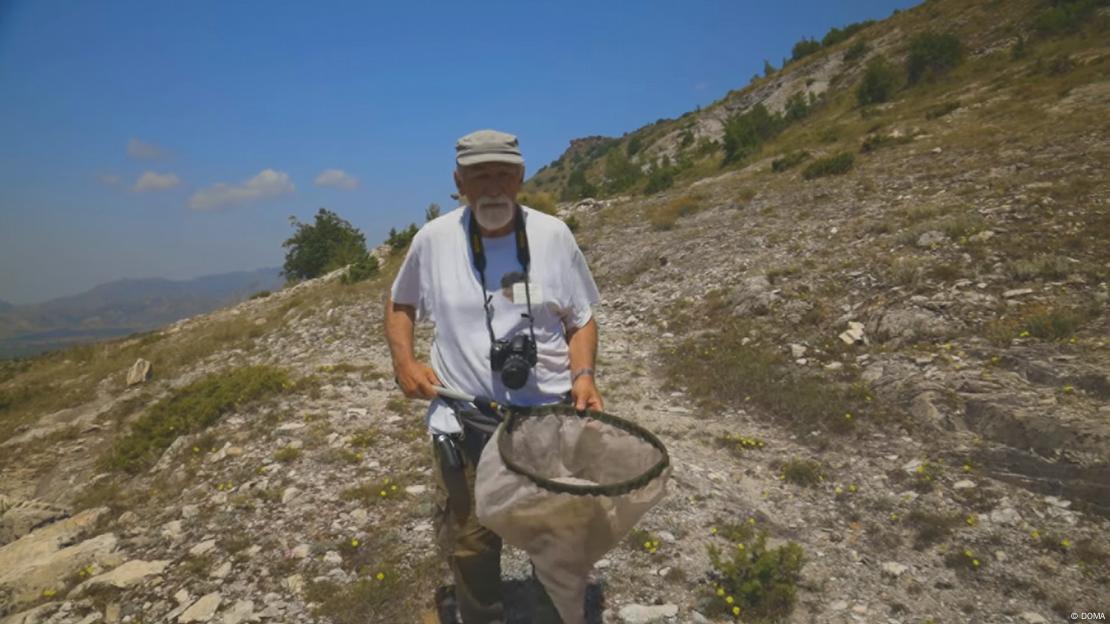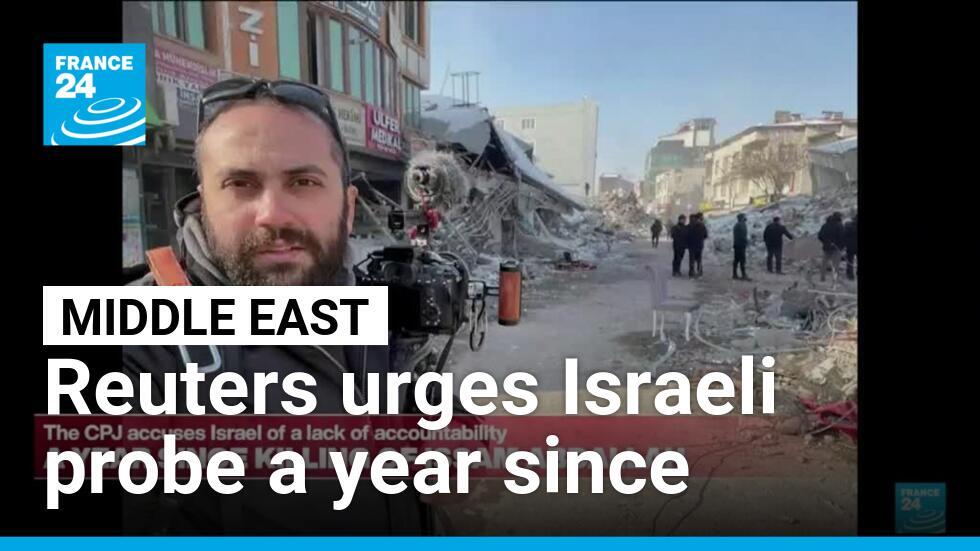October 10, 2024
Although the Macedonian Grayling is a critically endangered species of butterfly, it is legally available for sale online. The threat not only to this butterfly but to the ecosystem in North Macedonia is growing.
https://p.dw.com/p/4ldtC
Although the Macedonian Grayling is a critically endangered species of butterfly, it is legally available for sale online. The threat not only to this butterfly but to the ecosystem in North Macedonia is growing.
https://p.dw.com/p/4ldtC
The Macedonian Grayling is a "critically endangered" species of butterfly found only in North Macedonia
Image: Velijan Jagev
The Macedonian Grayling is one of Europe's most endangered butterflies. It can only be found in one place in the entire world: the hills around the village of Pletvar in North Macedonia.
Its habitat measures no more than about 1.5 sq. kilometers (about half a sq. mile) and consists mainly of rocks and certain types of grass on which the Grayling feeds while a caterpillar.
The Macedonian Grayling is a pollinator, which means that it carries pollen from one plant to another. By doing so, it ensures the survival and propagation of a number of flowers that provide nectar not only for the Macedonian Grayling, but for other insects, too.

The Macedonian Grayling is one of Europe's most endangered butterflies. It can only be found in one place in the entire world: the hills around the village of Pletvar in North Macedonia.
Its habitat measures no more than about 1.5 sq. kilometers (about half a sq. mile) and consists mainly of rocks and certain types of grass on which the Grayling feeds while a caterpillar.
The Macedonian Grayling is a pollinator, which means that it carries pollen from one plant to another. By doing so, it ensures the survival and propagation of a number of flowers that provide nectar not only for the Macedonian Grayling, but for other insects, too.

Entomologist Vladimir Krpac worries that the Macedonian Grayling might become extinctImage: DOMA
Each of these insects is a crucial part of a complex and fragile ecosystem, and their survival depends on the functioning of the system as a whole. The greatest threat to this ecosystem is human activity.
Insufficient protection
For example, five out of seven privately run marble quarries in the region are located directly within the Grayling's habitat, further reducing its already small size and making it harder for the butterfly to survive.
"I am worried, because human activity in this area — right where it lives — is increasing every day," says entomologist Vladimir Krpac, who is an expert on the Macedonian Grayling. "It would be no surprise, if nothing significant is done, to lose this species that only lives in North Macedonia."
According to the International Union for Conservation of Nature (IUCN), which has declared the butterfly "critically endangered," declines in distribution or population size of between 6% and 30% have been recorded. Despite these alarming figures, no special measures are being taken to protect the butterfly.

Each of these insects is a crucial part of a complex and fragile ecosystem, and their survival depends on the functioning of the system as a whole. The greatest threat to this ecosystem is human activity.
Insufficient protection
For example, five out of seven privately run marble quarries in the region are located directly within the Grayling's habitat, further reducing its already small size and making it harder for the butterfly to survive.
"I am worried, because human activity in this area — right where it lives — is increasing every day," says entomologist Vladimir Krpac, who is an expert on the Macedonian Grayling. "It would be no surprise, if nothing significant is done, to lose this species that only lives in North Macedonia."
According to the International Union for Conservation of Nature (IUCN), which has declared the butterfly "critically endangered," declines in distribution or population size of between 6% and 30% have been recorded. Despite these alarming figures, no special measures are being taken to protect the butterfly.

Prof. Andreas Segerer says that collecting rare butterflies for the sake of owning something rare can harm that butterfly's population
Image: Yellow Sunshine
That being said, the Macedonian Grayling has been protected by Macedonian law since 2011. As a result, special permits are required to collect it. These permits are only available to scientists.
But that doesn't stop poachers. Due to the lack of protective measures and because the law is not properly enforced, collecting this critically endangered butterfly is child's play: Poachers simply have to stroll through the Pletvar hills and gather the Grayling. The specimens they collect are then sold to collectors online.
Just a few clicks away
It's not hard to find samples of the Macedonian Grayling online. For less than €30 (just under $33), collectors can purchase an illegally poached specimen without fear of any legal consequences.
"Banning hunting won't solve anything," a seller, who prefers to remain anonymous, told DW. "Amateur collectors will not be affected. This has been going on for decades, and there are still plenty of butterflies here. It's like a fruit tree. Every year you harvest all the fruits, and next year there will be more."

That being said, the Macedonian Grayling has been protected by Macedonian law since 2011. As a result, special permits are required to collect it. These permits are only available to scientists.
But that doesn't stop poachers. Due to the lack of protective measures and because the law is not properly enforced, collecting this critically endangered butterfly is child's play: Poachers simply have to stroll through the Pletvar hills and gather the Grayling. The specimens they collect are then sold to collectors online.
Just a few clicks away
It's not hard to find samples of the Macedonian Grayling online. For less than €30 (just under $33), collectors can purchase an illegally poached specimen without fear of any legal consequences.
"Banning hunting won't solve anything," a seller, who prefers to remain anonymous, told DW. "Amateur collectors will not be affected. This has been going on for decades, and there are still plenty of butterflies here. It's like a fruit tree. Every year you harvest all the fruits, and next year there will be more."

The Macedonian Grayling's habitat extends over an area measuring just 1.5 sq. kilometers
Image: Velijan Jagev
Prof. Andreas Segerer, entomologist at the Zoologische Staatssammlung in Munich, Germany, confirms that poaching is not necessarily a problem when it comes to insects. Unlike amphibians or mammals, insects reproduce in their millions to secure their survival.
Even though entomologists like Segerer need dead specimens for their scientific work, he disapproves of collecting butterflies for anything but scientific purposes.
"Some collectors are motivated by the desire to possess a rare object," he says. "I do not think that is a good motive for collecting, and in individual cases — such as perhaps with this species, which is still very rare — this can harm its population."
Legal loopholes
The reason why the Macedonian Grayling can be legally purchased within the European Union has to do with the way protection works internationally.
While poaching, selling and exporting the butterfly is illegal in North Macedonia, distribution within the European Union is in fact legal.
The EU bases the legality of trade in animals and plants on CITES, the Convention on International Trade in Endangered Species of Wild Fauna and Flora. The treaty was signed in 1973 in Washington D.C. and contains lists of species that are internationally recognized as endangered.

Prof. Andreas Segerer, entomologist at the Zoologische Staatssammlung in Munich, Germany, confirms that poaching is not necessarily a problem when it comes to insects. Unlike amphibians or mammals, insects reproduce in their millions to secure their survival.
Even though entomologists like Segerer need dead specimens for their scientific work, he disapproves of collecting butterflies for anything but scientific purposes.
"Some collectors are motivated by the desire to possess a rare object," he says. "I do not think that is a good motive for collecting, and in individual cases — such as perhaps with this species, which is still very rare — this can harm its population."
Legal loopholes
The reason why the Macedonian Grayling can be legally purchased within the European Union has to do with the way protection works internationally.
While poaching, selling and exporting the butterfly is illegal in North Macedonia, distribution within the European Union is in fact legal.
The EU bases the legality of trade in animals and plants on CITES, the Convention on International Trade in Endangered Species of Wild Fauna and Flora. The treaty was signed in 1973 in Washington D.C. and contains lists of species that are internationally recognized as endangered.

Audrey Chambaudet feels that a revision of the EU's Environmental Crime Directive would help combat illegal wildlife tradeImage: EMG
Any trade in animals or plants on this list is illegal in the EU and enforced by the Wildlife Directive. However, the Macedonian Grayling is not yet on this list. Although it has a good chance of becoming so in the future, a number of obstacles still have to be overcome before that happens.
Although the Macedonian Grayling is on the IUCN red list, which is a necessary requirement to be internationally protected by CITES, CITES has not yet made a final decision on the case of this endangered butterfly.
A blind spot for insects?
Despite the fact that pollinating insects are crucial for the food supply of most living creatures on the planet, they are not on the radar of many environmentalists.
"I think there is a blind spot for insects at the moment, probably because they are not very charismatic," says Audrey Chambaudet, who deals with questions of wildlife trade at the World Wide Fund For Nature (WWF) in Brussels.
Although Chambaudet considers the current legal framework for wildlife trade sufficient, she does feel it needs to be updated.

Any trade in animals or plants on this list is illegal in the EU and enforced by the Wildlife Directive. However, the Macedonian Grayling is not yet on this list. Although it has a good chance of becoming so in the future, a number of obstacles still have to be overcome before that happens.
Although the Macedonian Grayling is on the IUCN red list, which is a necessary requirement to be internationally protected by CITES, CITES has not yet made a final decision on the case of this endangered butterfly.
A blind spot for insects?
Despite the fact that pollinating insects are crucial for the food supply of most living creatures on the planet, they are not on the radar of many environmentalists.
"I think there is a blind spot for insects at the moment, probably because they are not very charismatic," says Audrey Chambaudet, who deals with questions of wildlife trade at the World Wide Fund For Nature (WWF) in Brussels.
Although Chambaudet considers the current legal framework for wildlife trade sufficient, she does feel it needs to be updated.

Ilaria Di Silvestre feels that trade in a species should automatically be illegal if that species is protected in its country of originImage: EMG
"I think from a legislative perspective, the biggest improvement we need is a revision of the [EU's] Environmental Crime Directive," she says. Chambaudet hopes that by strengthening the system, prosecution of illegal wildlife trade can be made more efficient.
A change in European legislation would help
Ilaria Di Silvestre of the International Fund for Animal Welfare (IFAW) agrees that the Environmental Crime Directive needs to be strengthened. But instead of regulating the import of animals on the basis of CITES alone, she would prefer to see a system that is aligned with the US's Lacey Act.
"This is legislation that makes it a criminal offence to trade in species that are protected in the country of origin," she says. In the case of the Macedonian Grayling, that would mean that trade in this butterfly would automatically be illegal in the EU, without the need for meeting any further criteria.
All stakeholders agree that the loss of biodiversity has the potential to cause even greater damage than climate change. The loss of species within ecosystems — even if it is just the loss of something as apparently tiny as an insect — can have a major impact on the ecosystem as a whole, which in turn can have serious implications for all life on Earth — including humans.
Edited by: Aingeal Flanagan
This report was funded by journalismfund.eu. The investigation was a collaboration between DW and the Institute of Communication Studies in Skopje. A film was also produced as part of this project
"I think from a legislative perspective, the biggest improvement we need is a revision of the [EU's] Environmental Crime Directive," she says. Chambaudet hopes that by strengthening the system, prosecution of illegal wildlife trade can be made more efficient.
A change in European legislation would help
Ilaria Di Silvestre of the International Fund for Animal Welfare (IFAW) agrees that the Environmental Crime Directive needs to be strengthened. But instead of regulating the import of animals on the basis of CITES alone, she would prefer to see a system that is aligned with the US's Lacey Act.
"This is legislation that makes it a criminal offence to trade in species that are protected in the country of origin," she says. In the case of the Macedonian Grayling, that would mean that trade in this butterfly would automatically be illegal in the EU, without the need for meeting any further criteria.
All stakeholders agree that the loss of biodiversity has the potential to cause even greater damage than climate change. The loss of species within ecosystems — even if it is just the loss of something as apparently tiny as an insect — can have a major impact on the ecosystem as a whole, which in turn can have serious implications for all life on Earth — including humans.
Edited by: Aingeal Flanagan
This report was funded by journalismfund.eu. The investigation was a collaboration between DW and the Institute of Communication Studies in Skopje. A film was also produced as part of this project











